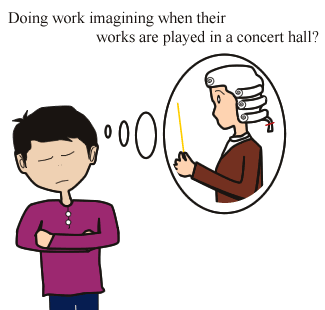- HOME
- Ono Sokki's Patio
- Music Hall Sound

Music Hall Sound
Ken: Dad, you told Beethoven played a horn sonata with a piano tuned lower by a semitone tuning higher by half on his own, didnt you?
Dad: Oh, you are talking about the story that Beethoven has an absolute pitch.
Ken: I listened to music composed by the Romantics such as Brahms and Mahler in a music class today. There was no gramophone record in those days. Was music played in a music hall?
Dad: It was played in a manor house of European aristocracy till the end of 18th century. The oldest one for symphony existing is in a town called Eisenstadt on the border between Austria and Hungary. They say a lord used a part of a castle as a patron for Haydn, father of symphony.
Ken: Music was played for aristocracy. Since when did they build a hall for people?
 Dad: The first music hall built by people which was not only
for a king or aristocrats was the old Gewandhaus, where
Mendelssohn was a music director and Berlioz and
Chaikovski conducted and played their own works, they
say. In the late 19th century, the works of Bach, Hendel
and Mozart were established as classic, and Beethovens
works were pivotal repertoires in a concert at that time
when it had been several decades since his death. The
four symphonic numbers of Brahms which you enjoyed today
were composed around that time. In fact many concert
halls existing with best sound were built in the late
19th century.
Dad: The first music hall built by people which was not only
for a king or aristocrats was the old Gewandhaus, where
Mendelssohn was a music director and Berlioz and
Chaikovski conducted and played their own works, they
say. In the late 19th century, the works of Bach, Hendel
and Mozart were established as classic, and Beethovens
works were pivotal repertoires in a concert at that time
when it had been several decades since his death. The
four symphonic numbers of Brahms which you enjoyed today
were composed around that time. In fact many concert
halls existing with best sound were built in the late
19th century.
Ken: Does it have a relationship with the fact that many of the Romantic composers appeared?
Dad: Im not sure but there is a certain relationship,
I suppose. The representative concert hall in 19th
century is Grosser Musikvereinssaal in Vienna, where
Brahms conducted from 1872 to 1875 as a Vienna
Philharmonic Orchestra conductor and so did Mahler in
1898. How interesting it is when I think that the
Orchestra sound with long reverberation in Grosser
Musikvereinssaal was the one maestros had in their mind
while they were composing!
Ken: Talking about it, the teacher said composers do work imagining when their works are played in a music hall.
Dad: Thats right. It is said that Haydn composed his symphony assuming it was played in a Haydnsaal. In older times, it is said many of pious music by Bach were for Thomas church. Thomas church has a reverberation time shortened to 1.6 second with many tapestries on walls in order to clarify bishops sermon. Bach made his works considering short reverberation time for a church.
Ken: Does reverberation time mean time required for the sound to vanish?
Dad: Reverberation
time is defined as the time required for the sound to decrease by 60dB
after stopping sounding.
In 1900, a scholar named W.C. Sabine first introduced the idea of
reverberation time in designing Boston Symphony hall. At that time, they
measured time till sound vanishes as you mentioned and pipes of a pipe
organ were the source of sound.
Ken: Measuring sound in a hall seems interesting. They use computers in measuring recently, dont they?
Dad: I will tell you later in detail about measuring or designing sound of hall.
Haydnsaal: This is in a castle of a lord, named Ester hazy, in Eisenstadt, Austria. Haydn worked for 30 years since 1761 as a court Kapellmeister there. It is sonorous with reverberation time of 2.8 seconds for low-pitched sound and 1.7 seconds for middle-pitched. (seat 500 people, completion in 1700)
The old Gewandhaus: It was in Leipzig, Germany. It was superseded by the second Gewandhaus and the third. (seat 300 people for ground floor and 200 people for the second floor, in 1781)
- © ONO SOKKI CO., LTD. 1996-2026
